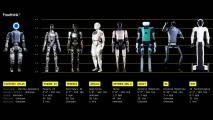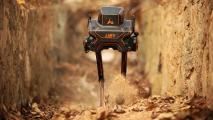With big eyes and blinking lights, robotic fish from Harvard’s Wyss Institute are putting an adorable new face on the admittedly scary-sounding field of “swarm robotics.”
Called the Bluebots, the robotic fish are cruising around their tank, capable of imitating dynamic motions of schools of real fish, like the tornado-like defensive behavior called milling.
The research, published in Science Robotics, is the first time complex 3D swarm behaviors have been modeled underwater, Wyss’s release announced.
The potential for robot swarms is big, and underwater swarms open up new possibilities. As WIRED’s Matt Simon points out, they could possibly be trained to hunt down invasive species, like lionfish, honing in on the predatory beauty’s frilly silhouette.
Unaffiliated robotics projects, like Pliant Energy Systems’ deep-sea mining prototype, also envision using swarms to get their work done. Robot bees could plie the skies above orchards, pollinating crops, or buzz through the debris of a collapsed building, looking for survivors. The DoD’s already flown a swarm of micro-drones out at China Lake.
The robotic fish’s enormous, Disney-like eyes are cameras that give Bluebots almost 360-degree vision. They’re looking for the blue LED lights on other fish-bots, which are exactly 86 millimeters apart. Based on how bright and clear the LEDs look, the bots can gauge the distance between it and its buddies.
“Just by observing how far or close they are in a picture, they know how far or close the robot must be in the real world,” Harvard biologist Florian Berlinger told Simon.
Armed with that knowledge, the researchers can give the robotic fish simple algorithmic commands to generate some pretty impressive collective behaviors.
“The rule was: If there is at least one robot in front of you, you turn slightly to the right,” Berlinger told Simon. “If there is no robot in front of you, you turn slightly to the left.”
These simple rules can generate coordinated, swarm-like behavior from the bottom up, as though they were being choreographed or directed by a single leader.
In another mission, the Bluebots were tasked with spreading out and finding a red LED. When one did, it began to blink its own LED, attracting nearby robotic fish, who then began to blink, attracting more Bluebots, and so on.
The search mission also demonstrated the robotic fish’s abilities to both disperse and aggregate — pretty intricate self-organized behaviors.
That’s the promise of swarm robotics: combining many smaller, simpler robots to achieve complex, group tasks.
Robotic fish aren’t the only swarm with a nod to nature; synchronized fireflies, flocks of birds, and the behaviors of colonial insects like ants serve as models for the power of a swarm.
Tribots, developed at Switzerland’s École polytechnique fédérale de Lausanne (EPFL), take their inspiration from trap-jaw ants. While these ants generally walk around like usual, they sometimes snap their titular jaws like a catapult, launching them away from danger.
The Tribots mimic this move, giving them an extra mobility option for complicated environments. But more importantly than moving like ants, they operate like ants.
“Each Tribot, just like Odontomachus (trap-jaw) ants, can have different roles. However, they can also take on new roles instantaneously when faced with a new mission or an unknown environment, or even when other members get lost. This goes beyond what the real ants can do,” EPFL’s Jamie Paik told ZDNet.
No matter what the robotic swarm’s future, however, it seems unlikely that any of them will top the Bluebots in cuteness.





